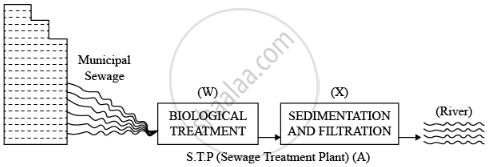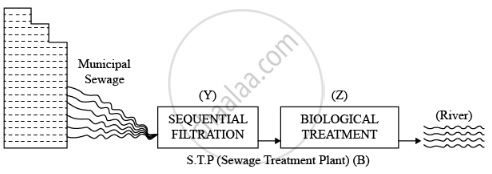Advertisements
Advertisements
Question
What is sewage? In which way can sewage be harmful to us?
Solution
Sewage is a collective word for municipal waste water (both liquid and solid wastes) generated in cities and towns and taken away in sewers. Chemically, sewage is made up of around 99% water and 1% solid waste, which includes both inorganic and organic stuff. Sewage contains bacteria (coliforms, streptococci, clostridia, lactobacilli), microfungi, protozoa, and microalgae. Proper sewage disposal is critical because untreated sewage in rivers and other bodies of water can be hazardous in the following ways:
- It leads to the spread of waterborne diseases caused by bacteria.
- It could reduce the dissolved oxygen (DO) in water. Reduced oxygen availability has the potential to kill aerobic aquatic bacteria.
- Untreated sewage generates an unpleasant smell.
APPEARS IN
RELATED QUESTIONS
Explain the function of “anaerobic sludge digester” in a sewage treatment plant.
Removal of large pieces of floating debris, oily substances, etc. during sewage treatment is called _______________.
Why is this sewage water treatment essential?
Due to which of the following reason/s sewage water cannot be discharged directly into river?
In the process of biogas production which of the following anaerobic bacteria are used?
What happens during the course of sewage decomposition?
After which of the following treatment BOD of the effluent is significantly reduced?
Which of the following is put into Anaerobic sludge disaster for further sewage treatment?
BOD of waste water is estimated by measuring the amount of ______.
What would happen if oxygen availability to activated sludge flocs is reduced?
Name the states involved in Ganga action plan.
What is the group of bacteria found in both the rumen of cattle and shidge of sewage treatment?
Discuss about the major programs that the Ministry of Environment and Forests, Government of India, has initiated for saving major Indian rivers from pollution.
In what way anaerobic sludge digestion is important in sewage treatments?
Study the given diagram of the Sewage Treatment Plant (S.T.P.) and answer the question that follows:


- Which one of the two 'S.T.P.' (A) or (B) will be more effective in treating the human excreta in municipal waste?
- Write the steps followed in carrying the treatment of the sewage in step (Z), once the BOD of sewage is reduced significantly till it is passed on to the "anaerobic sludge digesters".
Given below is the flowchart of sewage treatment. Identify A, B, C, D and E and select the correct option.

Which of the following statement is correct for Sewage Treatment Plants (STPs)?
The aeration tank of a sewage treatment plant is not functioning properly. Explain in detail the impact of this on the treatment of sewage and BOD of the effluent.
Explain the steps involved in preliminary treatment of sewage.
